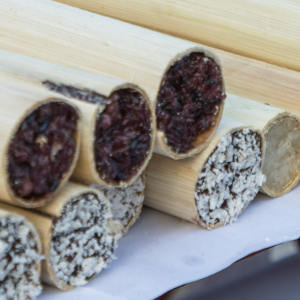‘Not what I expected’ continues to be the theme of our culinary trek through the mountains of Laos this week. And this installment of the series follows along in the same vein. While many dishes we would recognise as desserts come out of French colonial traditions, Laotians have others all their own…
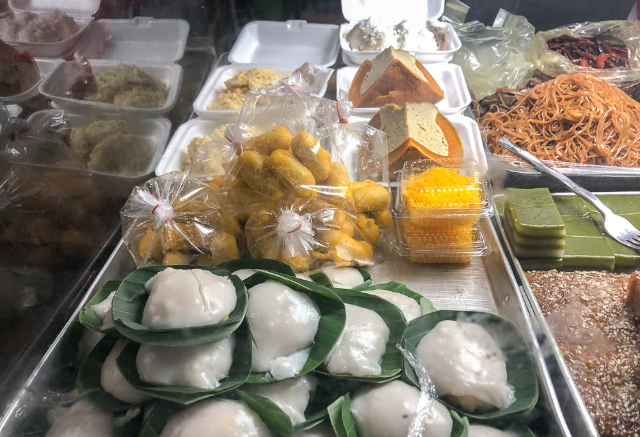 An array of popular Laotian sweets, at a roadside stand in rural Laos…
An array of popular Laotian sweets, at a roadside stand in rural Laos…
You’ll find the desserts the French brought with them to Laos in the cafés and ritzier restaurants of the major cities and towns. But in the realm of the common folk, Lao traditional ingredients combine with a prodigious national sweet tooth to provide a wide variety of treats Laotians will consume any time of the day or night. And as in other cultures we’ve examined, sweets play a major role in Laotian festivals and ceremonies.
Those ingredients we mentioned include sugar, rice, coconut and (of course) fresh fruit. Traditional Lao sweets are almost always sold by street vendors or at open-air markets – except for the special ceremonial concoctions, which are generally made in the home, with the whole family taking part.
On our menu today
Khao Niaow Mak Muang: Sticky Rice with Mango. A classic pairing of the uber Lao staple (rice) with one of the most plentiful of the country’s fresh fruits. It’s street food, served on a banana leaf to go. In fact, the banana leaf is the official ‘plate’ of the Laotian street food scene.
Khao Khop: Sweetened sticky rice that has been formed into flat spirals, deep fried and drizzled with Palm Sugar Syrup.

This one is a rural favourite, found at roadside stands and markets.
Khao Lahm: Sticky Rice mixed with coconut milk and pressed into a section of hollow bamboo stalk (see pohoto, top of page). You peel the bamboo back, eating the sweet filling as you go. Not unlike eating a banana.
Ma Muang Dip Sai Jeow: Green mango with a sweet and spicy dip (the Jeow). This treat is said to be a tea and lunch break favourite of big city office workers
Ta Koh: Coconut Cream Cakes. They’re basically a steamed tapioca custard in a banana leaf bowl.
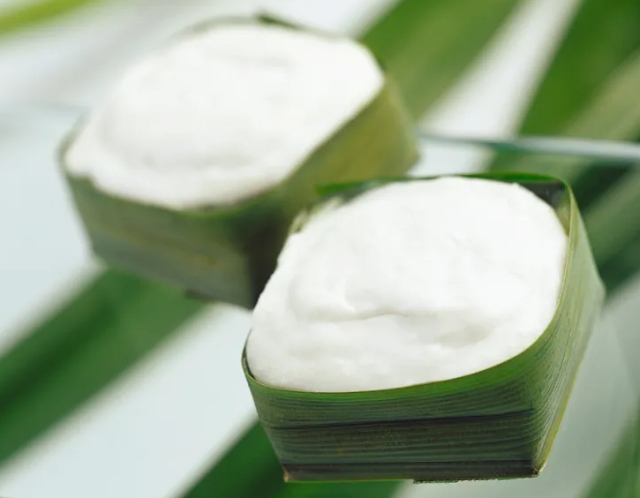
Ingredients include coconut cream, coconut pulp, tapioca flour and sugar. Elegant-looking little creamy mouthfuls…
Kanom San: Layered Jellies. Made from rice flour and agar (a gelling agent often used in molecular cuisine recipes), these jelly squares are usually two-layered, one solid and the other translucent. They come in all colours and flavours, but the most common is the green-over-white version sold by street vendors everywhere in Laos.
Patongo: The famous ‘Chinese style’ Lao Doughnut. Made with All-Purpose wheat flour, and (often) corn starch added for crispy lightness. This authentic recipe does not use corn starch, but requires longer prep time and more careful handling.
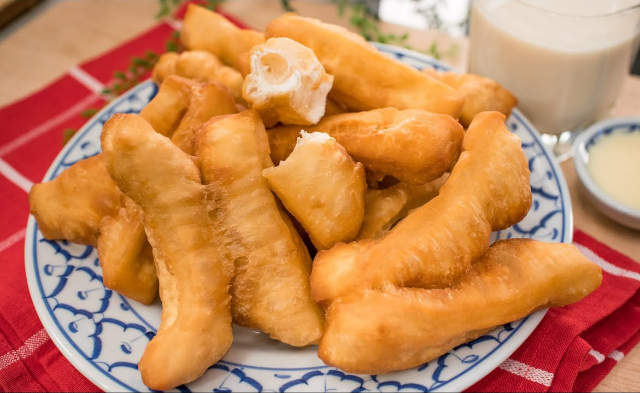
Patongo are traditionally formed as straight sticks and paired. The street story is, they’re like two lovers in the throes… Everybody loves them. They are faves with both savoury and sweet dips and soups. And… There’s a smaller (finger-sized) version of the Patongo, formed in single rather than twinned sticks, which folks refer to in street slang, as ‘Cat Poos’. Really. They’re considered a delicacy.
These are just a few of the many forms and flavours of Laotian sweets. Visit this great site if you want to get a real, comprehensive overview of desserts and street treats. I think I gained 5 pounds just writing about a few!
Beverages
Lao Lao: Two different words, both spelled and pronounced the same. Only in Laos? In one usage, ‘Lao’ is a short form for ‘Laotian’. in then other, it’s Laotian for ‘alcohol’. When used to describe a specific beverage, it means Laotian Rice Whiskey.
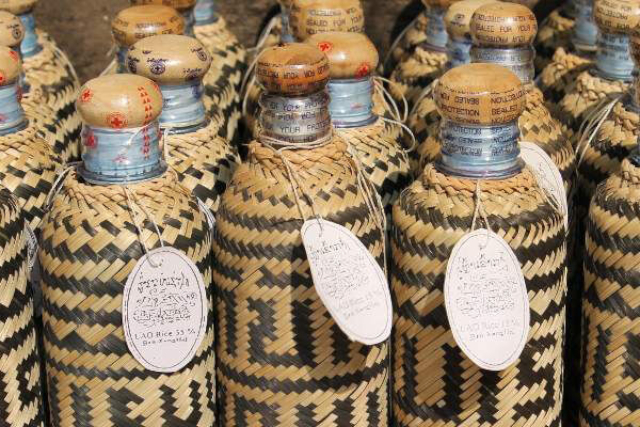
One Laotian website says, “Lao Lao is one of the cheapest alcohols in the world. The tourist [who] comes here will be amazed by many handmade bottles contain the visible liquid with the shocking price in the local market. The low price doesn’t mean it has poor quality; instead, the taste is good and definitely will give you a hangover.”
Beerlaos: A German style lager beer made from Laotian Jasmine Rice teamed with German hops and yeast. Beerlaos has received international awards and is exported to a number of countries in Europe and North America.
Saa: Tea – Black or Green. Everybody drinks tea in Laos, at one time or another during the day.
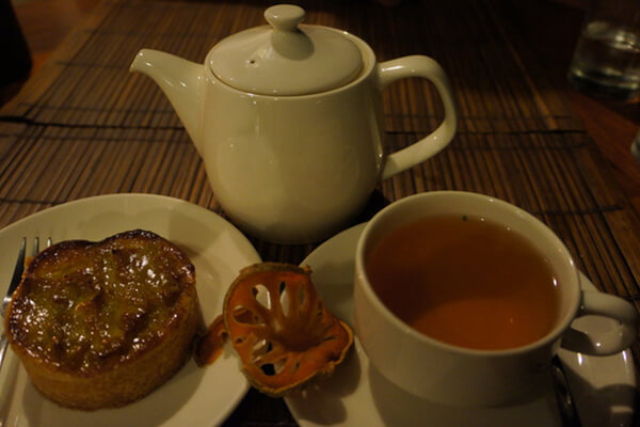
Black Tea is usually served in coffee shops, with condensed milk and sugar, while Green Tea is served in every restaurant and café, usually for free – like a glass of water in European and North American restos
Café Paksong: A special coffee drink made from high-quality Laotian mountain-grown coffee, brewed strong in a drip processor and layered over a couple of oz. / about 60 ml of sweetened condensed milk. You’re supposed to mix it up before drinking. No extra sweetener is added. But you will probably want to mix the cup well; it’s a strong brew!
Sugar Cane Juice: A great energy-restorer, full of sucrose and fructose. Laotians love it on a hot day.
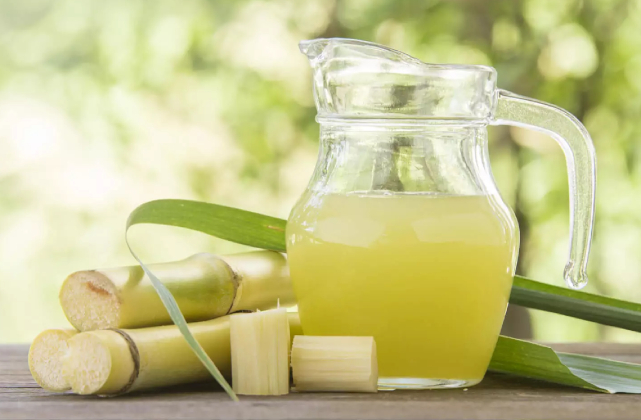
Coconut Water: Another great heat-beater! Must be fresh and cool, from a freshly tapped coconut. Folks often just drink it right out of the coconut shell – with a straw.
Another intriguing Laotian interlude
No matter where you go or what you eat in Laos, you’re going to learn something new and experience something amazing! I hope this mind trek to Southeast Asia has inspired you to try some of the Laotion dishes we’ve touched on. They’re easy, and usually require only few ingredients – but you’ll want to make a shopping list and visit an authentic Asian grocery store to be sure you’ve got the real-deal ingredients that make Laotian food unique!
~ Maggie J.

